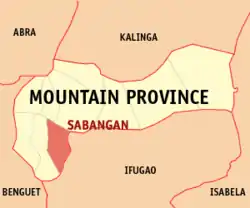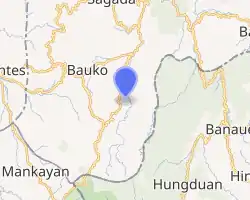Sabangan
Sabangan, officially the Municipality of Sabangan is a 5th class municipality in the province of Mountain Province, Philippines. According to the 2015 census, it has a population of 9,315 people. [3]
Sabangan | |
|---|---|
| Municipality of Sabangan | |
 Seal | |
 Map of Mountain Province with Sabangan highlighted | |
OpenStreetMap 
| |
.svg.png.webp) Sabangan Location within the Philippines | |
| Coordinates: 16°57′N 120°55′E | |
| Country | |
| Region | Cordillera Administrative Region (CAR) |
| Province | Mountain Province |
| District | Lone District |
| Barangays | 15 (see Barangays) |
| Government | |
| • Type | Sangguniang Bayan |
| • Mayor | Marcial C. Lawilao Jr. |
| • Vice Mayor | Dario P. Esden |
| • Representative | Maximo Y. Dalug Jr. |
| • Electorate | 7,834 voters (2019) |
| Area | |
| • Total | 72.04 km2 (27.81 sq mi) |
| Elevation | 1,441 m (4,728 ft) |
| Population | |
| • Total | 9,315 |
| • Density | 130/km2 (330/sq mi) |
| • Households | 2,215 |
| Economy | |
| • Income class | 5th municipal income class |
| • Poverty incidence | 19.07% (2015)[4] |
| • Revenue | ₱53,547,583.69 (2016) |
| Time zone | UTC+8 (PST) |
| ZIP code | 2622 |
| PSGC | |
| IDD : area code | +63 (0)74 |
| Climate type | tropical rainforest climate |
| Native languages | Balangao Bontoc Ilocano Tagalog |
| Website | www |
Barangays
Sabangan is politically subdivided into 15 barangays.
- Bao-angan
- Bun-ayan
- Busa
- Camatagan
- Capinitan
- Data
- Gayang
- Lagan
- Losad
- Namatec
- Napua
- Pingad
- Poblacion
- Supang
- Tambingan
Climate
| Climate data for Sabangan, Mountain Province | |||||||||||||
|---|---|---|---|---|---|---|---|---|---|---|---|---|---|
| Month | Jan | Feb | Mar | Apr | May | Jun | Jul | Aug | Sep | Oct | Nov | Dec | Year |
| Average high °C (°F) | 21 (70) |
23 (73) |
24 (75) |
26 (79) |
25 (77) |
25 (77) |
24 (75) |
24 (75) |
24 (75) |
24 (75) |
23 (73) |
22 (72) |
24 (75) |
| Average low °C (°F) | 15 (59) |
15 (59) |
16 (61) |
18 (64) |
19 (66) |
19 (66) |
19 (66) |
19 (66) |
19 (66) |
18 (64) |
17 (63) |
16 (61) |
18 (63) |
| Average precipitation mm (inches) | 35 (1.4) |
46 (1.8) |
63 (2.5) |
117 (4.6) |
402 (15.8) |
400 (15.7) |
441 (17.4) |
471 (18.5) |
440 (17.3) |
258 (10.2) |
94 (3.7) |
68 (2.7) |
2,835 (111.6) |
| Average rainy days | 9.9 | 19.5 | 13.9 | 18.9 | 26.0 | 27.3 | 28.9 | 28.5 | 26.1 | 19.7 | 14.5 | 12.8 | 246 |
| Source: Meteoblue [5] | |||||||||||||
Demographics
| Year | Pop. | ±% p.a. |
|---|---|---|
| 1903 | 49 | — |
| 1918 | 3,092 | +31.83% |
| 1939 | 4,706 | +2.02% |
| 1948 | 4,581 | −0.30% |
| 1960 | 8,900 | +5.69% |
| 1970 | 6,517 | −3.06% |
| 1975 | 7,599 | +3.13% |
| 1980 | 8,194 | +1.52% |
| 1990 | 8,083 | −0.14% |
| 1995 | 8,609 | +1.19% |
| 2000 | 8,728 | +0.29% |
| 2007 | 9,098 | +0.57% |
| 2010 | 8,741 | −1.45% |
| 2015 | 9,315 | +1.22% |
| Source: Philippine Statistics Authority [3] [6] [7][8] | ||
References
- Municipality of Sabangan | (DILG)
- "Province: Mountain Province". PSGC Interactive. Quezon City, Philippines: Philippine Statistics Authority. Retrieved 12 November 2016.
- Census of Population (2015). "Cordillera Administrative Region (CAR)". Total Population by Province, City, Municipality and Barangay. PSA. Retrieved 20 June 2016.
- "PSA releases the 2015 Municipal and City Level Poverty Estimates". Quezon City, Philippines. Retrieved 12 October 2019.
- "Sabangan: Average Temperatures and Rainfall". Meteoblue. Retrieved 8 March 2020.
- Census of Population and Housing (2010). "Cordillera Administrative Region (CAR)". Total Population by Province, City, Municipality and Barangay. NSO. Retrieved 29 June 2016.
- Censuses of Population (1903–2007). "Cordillera Administrative Region (CAR)". Table 1. Population Enumerated in Various Censuses by Province/Highly Urbanized City: 1903 to 2007. NSO.
- "Province of Mountain Province". Municipality Population Data. Local Water Utilities Administration Research Division. Retrieved 17 December 2016.
External links
This article is issued from Wikipedia. The text is licensed under Creative Commons - Attribution - Sharealike. Additional terms may apply for the media files.
